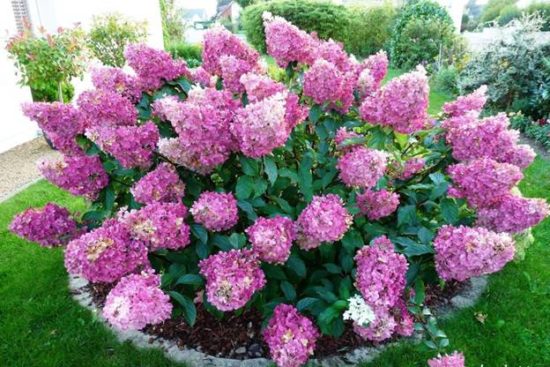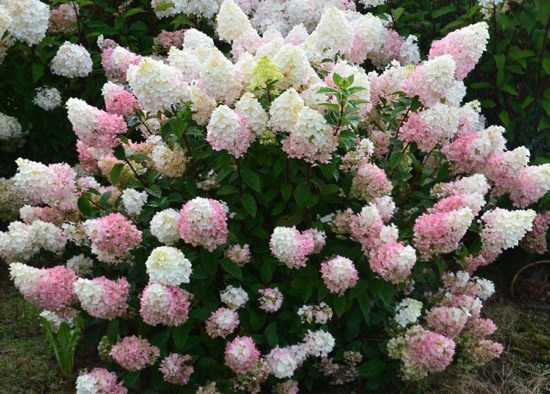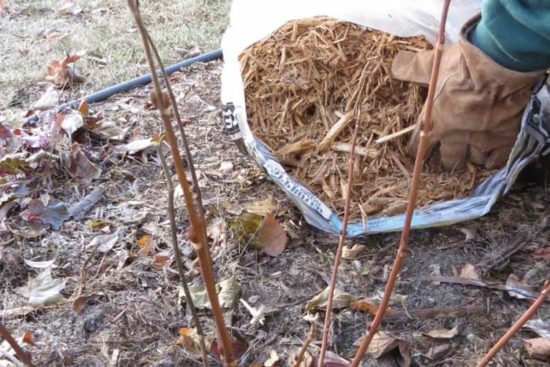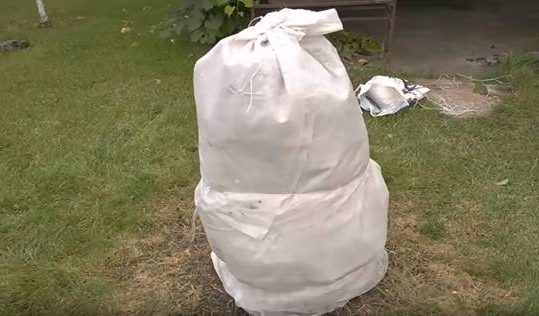Pruning a paniculate hydrangea bush
| Content:
|
Paniculata hydrangea is a small shrub, known for its unpretentious cultivation and a long wave of gorgeous flowering.It has a pronounced cone-shaped, elongated inflorescence, which differs from tree-like hydrangeas, which have spherical panicles.
|
Hydrangea paniculata Sunday Fries in bloom |
Unlike the tree-like hydrangea, which grows in width due to shoots, the paniculate representative is compact, the shoots grow from almost one place, the bush does not spread new stems from underground. The culture branches well and produces many new shoots on one stem.
Pruning is the most important component in caring for paniculate hydrangeas. Correctly and timely procedure is the key to longevity and decorativeness of the plant.
With the help of properly carried out pruning, you can shape a shrub, making it compact and spherical, tall and spreading, or give the shape of a tree, forming it on a trunk.
Pruning also has a rejuvenating effect on older bushes. Over the years of growing season, the skeletal shoots age, the crop grows many frail, useless branches. By removing excess ballast, you can give the plant a second life.
When is the best time to prune hydrangeas?
Paniculata hydrangea can be pruned both in spring and autumn; there is no strict rule. In each case there are nuances, so the gardener can choose the period that is most suitable for him.
- Spring pruning of hydrangeas. Not suitable for summer residents who cannot get to their plots in early spring. It is considered the most correct, but hides danger. After winter, hydrangeas begin to have strong sap flow, so it is important to correctly calculate the time of the procedure and do it when the buds are still sleeping. In northern latitudes, Moscow and Leningrad regions, you need to start in early March. In the southern regions, pruning is carried out in February.
In the spring, it is also advisable to carry out sanitary pruning, while removing frozen branches that were broken after the winter.
|
Pruning a hydrangea bush in spring |
- Autumn pruning. Suitable for those who cannot get to their garden plots due to snowdrifts in early spring. The procedure is carried out late, with the beginning of leaf fall, when the structure of the bush is clearly visible and the picture of the upcoming cleaning is clear. Autumn pruning protects shoots from damage under the weight of snow and ensures the health of the bush by neutralizing pest larvae and pathogen spores accumulated over the season.
Basic rules for pruning paniculate hydrangeas
Paniculata hydrangea is a flexible crop, it can be safely cut to height, and it recovers well. There are unshakable rules for pruning paniculate varieties:
- With low pruning (when only 2-3 buds are left from below), the plant has few buds left. All nutrition from the roots will be distributed to the small number of remaining buds. Each shoot will receive sufficient nutrition, grow powerful, strong and produce large inflorescences. The result will be a compact bush with a small number of strong branches with huge panicles.
- If you do not cut it short, leaving 4,5,6 internodes below, the bush will distribute its strength between all the remaining buds. In this case, future shoots will receive less nutrients, grow small and produce small inflorescences. The result will be a wide and tall bush with many medium branches and a cap of small panicles.
- Another pruning rule is that the thinner the shoot, the lower it needs to be cut.
Important! The procedure is carried out with a disinfected, sharpened instrument in order to cut off the unnecessary stem in one motion. A dull pruner will crush the bark and capillaries inside the shoot.
Before pruning, pay attention to the shoots. You can notice that they are different in thickness. First of all:
- All weak and thin branches are completely cut off at the base. They shade the bush, make ventilation difficult, and take away nutrition from the main shoots. They are not used as material for cuttings; they are simply disposed of.
- Medium branches, not thick, but not thin, the size of a pencil, are also not desirable; they are removed. If there are several such shoots on a branch, it is removed completely at the base. With such pruning, the plant will redistribute its forces and give them to larger shoots. Such medium-sized branches will already be used for cuttings.
- Having cleared the bush in this way, they examine the remaining thick shoots and buds. The gardener decides what he wants to get. You can carry out gentle pruning, in which more than 3 internodes are left on the main and secondary shoots. Or you can cut all the branches very short - to the stump, 15-20 cm from the ground. In this case, some varieties need to be tied up, because not all shoots are capable of holding huge heads of inflorescences.
|
The result of short pruning is a compact, powerful bush. |
Attention! All sections are made at an angle of 45°C, 1 cm above the healthy kidney. A tool with long, tapered blades will make the job easier.
|
The result of gentle pruning is a wide bush with many inflorescences |
Open cuts are conductors for pathogens of fungal and infectious diseases and pests. After any pruning, the wounds are covered with garden varnish or treated with charcoal.
Pruning young paniculate hydrangeas
Any pruning is stressful for hydrangea. The young plant is not pruned in the first two years after planting.This time is necessary for the culture to:
- Build up a good root system, which is underdeveloped in a recently planted seedling.
- Grow shoots. Even if a young bush has grown good branches over the season by autumn, they should not be pruned. By autumn, a bush planted in spring will accumulate a large amount of nutrients, thanks to which it will successfully survive the winter.
Young hydrangea bushes begin to be pruned in the fall of the second year, and preferably in the spring of the third year after planting. The first pruning is done depending on the condition of the existing shoots.
If the stems are not strong enough and of medium thickness, it is better to trim them lower. Shortening the branches by 2 buds from below will ensure the revival of new straight, strong shoots from their axils.
If the shoots are strong, strong and in the future you need to get a tall bush, low pruning is not necessary. The stems should be shortened to the desired height - 4,5,6 buds from below.
Pruning old panicle hydrangeas
Adult bushes over 10 years old need anti-aging pruning. It will revive lost decorativeness, awaken dormant buds on old branches, and provoke the growth of new powerful shoots.
The procedure is preferably carried out in the fall. Since the bush is mature, pruning will weaken it, but will not prevent it from surviving the winter.
Hydrangea pruning is carried out without fanaticism. You should not delete all old branches at once. Dormant buds may not wake up, in which case the plant can be destroyed.
Typically, an older bush consists of many main, thick, woody, gray shoots with many branches on each. They are not removed immediately, but over several seasons. Pruned at a height of 20 cm above the ground, depending on the structure of the bush.Thus, along with one old stem, a lot of branches thickening the crown are removed.
It is also important to look inside the bush and remove all small, thin, weak, broken stems, as well as those growing in the center of the plant, crossing other branches.
After such pruning, the hydrangea bush will gradually clear itself of the old, unnecessary mass, grow new shoots and will consist only of young, bright brown stems.
Preparing hydrangea for winter
They begin to prepare the plant for wintering after leaf fall:
- They clear the tree trunk circle of fallen leaves, in which pest larvae and disease spores overwinter well. The collected litter is burned.
- Loosen the soil around the stem, simultaneously scattering granular phosphorus-potassium fertilizer. It will help the plant to withstand cold weather.
- Carry out water-recharging irrigation. Water will dissolve the applied fertilizer, deliver it to the roots and ensure digestibility. All parts of the crop will be saturated with moisture, which will protect the bush from freezing.
Paniculate hydrangeas are classified as absolutely winter-hardy plants that do not require shelter. However, there are points that should be taken into account for a successful wintering of the seedling:
- Plant age. Young bushes pruned in autumn must be sprinkled with leaves and pine litter. To prevent the shelter from being blown away by the wind, a wooden box is placed on top. Unpruned young seedlings are bent to the ground, the branches are fixed, and covered with spruce branches on top. For adult bushes, it is enough to increase the layer of mulch around the growth perimeter to 20-25 cm.
|
Increasing the layer of mulch - protection for the root system in winter |
- Place of growth. Paniculata hydrangea is not afraid of frosts down to -35°C.However, you can’t predict the weather; lately, winters are often snowless, often alternating with frosts and thaws. Such swings are dangerous for bushes. If you wrap it up, you can harm the plant; it will dry out. Do not close - there is a risk of freezing in snowless winters.
If hydrangea grows in northern latitudes, it is better to pour a high layer of mulch into the tree trunk, thus protecting the roots from freezing. Pine and spruce litter and high-moor peat are well suited. To be on the safe side, the plant can be wrapped in spunbond and secured around it with a rope.
In the southern regions, it is enough to increase the mulch layer.
|
Cocoon made of covering material - reliable protection of the above-ground parts of the plant |
Don't forget to read:
Forming paniculata hydrangea on a trunk with your own hands ⇒
Similar articles:
- How to prune tree hydrangea correctly ⇒
- Pruning large-leaved hydrangea for beginners ⇒
- How to prune ground cover roses ⇒
- The best varieties of paniculate hydrangeas with photos and descriptions ⇒
- Rules for planting and caring for paniculate hydrangeas ⇒







 CUCUMBERS NEVER GET SICK, I'VE BEEN USING ONLY THIS FOR 40 YEARS! I SHARE A SECRET WITH YOU, CUCUMBERS ARE LIKE THE PICTURE!
CUCUMBERS NEVER GET SICK, I'VE BEEN USING ONLY THIS FOR 40 YEARS! I SHARE A SECRET WITH YOU, CUCUMBERS ARE LIKE THE PICTURE! You can dig a bucket of potatoes from each bush. Do you think these are fairy tales? Watch the video
You can dig a bucket of potatoes from each bush. Do you think these are fairy tales? Watch the video
 How our fellow gardeners work in Korea. There is a lot to learn and just fun to watch.
How our fellow gardeners work in Korea. There is a lot to learn and just fun to watch. Eye trainer. The author claims that with daily viewing, vision is restored. They don't charge money for views.
Eye trainer. The author claims that with daily viewing, vision is restored. They don't charge money for views. A 3-ingredient cake recipe in 30 minutes is better than Napoleon. Simple and very tasty.
A 3-ingredient cake recipe in 30 minutes is better than Napoleon. Simple and very tasty. Therapeutic exercises for cervical osteochondrosis. A complete set of exercises.
Therapeutic exercises for cervical osteochondrosis. A complete set of exercises. Which indoor plants match your zodiac sign?
Which indoor plants match your zodiac sign? What about them? Excursion to German dachas.
What about them? Excursion to German dachas.